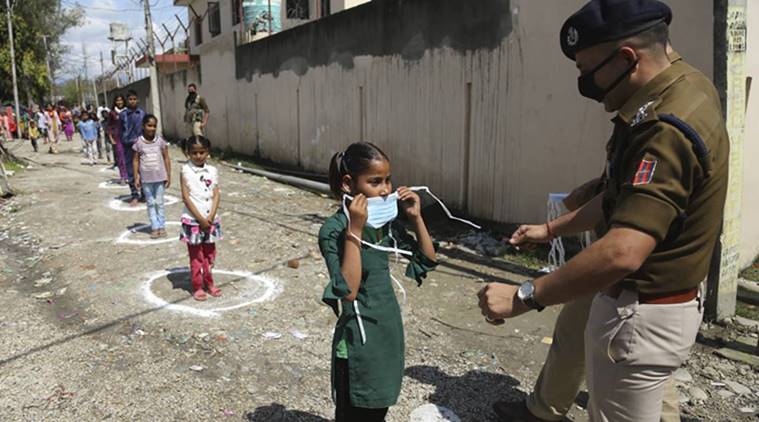 Responding to the tweet, the official handle of the Deputy Commissioner posted: “kind of words that U have used in this tweet r inflammatory in nature & liable for penal action.” (Representational)
Responding to the tweet, the official handle of the Deputy Commissioner posted: “kind of words that U have used in this tweet r inflammatory in nature & liable for penal action.” (Representational)
Questions are being raised in Jammu over the designation of two Muslim-dominated localities as COVID-19 red zones since March 29, where no positive case has been recorded so far.
The administration has responded by claiming that 10 positive cases have been recorded from the area as a whole, and that more than 45 “high risk” contacts of those cases reside here. It has also threatened action against a local Youth National Conference leader, who raised the issue, accusing him of using “inflammatory” words.
On Wednesday, Youth National Conference provincial secretary Zeeshan Javed Rana posted on Twitter: “Will the govt reveal the reason for declaring Bhatindi and Gujjar Nagar as Red Zones? Were the guidelines issued by @MoHFW_INDIA properly followed, or is it because of a Muslim majority population.’’ He also tagged J&K administration spokesperson Rohit Kansal and Jammu Deputy Commissioner Sushma Chauhan in the tweet.
Responding to the tweet, the official handle of the Deputy Commissioner posted: “kind of words that U have used in this tweet r inflammatory in nature & liable for penal action. Nevertheless for the record there r 10 +ve cases from the said Red zones, besides more than 45 high risk contacts of those who have turned positive elsewhere reside in these areas.”
Many of Jammu’s prominent politicians and officials, such as former J&K chief ministers Farooq Abdullah and Omar Abdullah, former minister Ghulam Hassan Mir who recently floated Apni Party, and former Advocate General A G Goni, own residences in Gujjar Nagar and Bhatindi.
A senior official pointed out that around six people, including two doctors, had tested positive in the Channi Himmat area nearby, but the administration did not declare it a red zone. Incidentally, Deputy Commissioner Chouhan stays in the Channi Himmat area.
Last month, Chauhan had exercised her powers under Section 144 of CrPC, and provisions of the Epidemic Diseases Act, 1897, and the Disaster Management Act 2005, to declare Bhatindi, Sunjwan and Gujjar Nagar areas, and Bhawani Nagar in Janipur, as Red Zones.
The move barred movement of all people in and out of these areas, except for medical emergencies for which they would have to contact a helpline.
Questioning the administration’s move, a senior official said: “The administration does not seem to have applied its mind while declaring these areas as red zones. It does not seem to have followed the SOP (Standard Operating Procedure) laid down by the UT administration.”
The SOP states that “areas with a significant number of cases, or where there is suspicion of cluster transmission, based on assessment by DC & CMO, with the advice of the SP as well, will be declared as Red Zones by Deputy Commissioner concerned’’, the official said.
According to Rana, Gujjar Nagar and Bhatindi “should not have been been in the red zone at all as there has been no positive case so far”.
“No one has detected positive, but those found infected were people from the Tabhligi Jamaat who were kept under quarantine at a mosque in the Sunjwan area. We are with the administration in the fight against this epidemic, but it should tell people in red zones since March 29 as to when they will be able to see some relaxation,’’ he said.
When contacted, Chauhan said there are two factors behind the declaration of an area as a red zone: reporting of a positive case and presence of high risk contacts. “Both Gujjar Nagar and Shahidi Chowk are adjoining localities and there was one positive case in Shahidi Chowk and over 45 high risk contacts of this case in Gujjar Nagar,” she said.
“After taking all those factors in mind, these kind of details have to be discussed with the SSP… while doing so, we try to keep a balance between what is desired by the Health Department and what is practically feasible on the ground,’’ she said.
Asked about the cases in Channi Himmat, she said that one of the doctors that tested positive lived with his family. “As he was well-informed about Covid-19 and dealing with such cases, he himself reported it very early and because of that we were able to test him and his family members,’’ she said.
“As their further contacts, all low risk contacts, tested negative, we took a considered decision that declaring the entire area as red zone was not required as all the contacts were detected very early before they could further come in contact with anyone,’’ she said.
Asked about other cases, she said: “One case does not qualify because her husband and children tested negative. When we came to these cases, we were able to track all their contacts very quickly within three to four hours. But in Sunjwan and Bhatindi, there were a large number of high risk contacts for each person infected,’’ she said.
On Friday, Rana responded to the administration’s tweet with a series of posts. “I didn’t anticipate such response from @dcjammuofficial accusing me of using inflammatory words. Since when is bringing attention of the officials to a prevalent situation making us liable for penal action,” he wrote.
Referring to news reports about “plight of people suffering in these localities”, he ended by “requesting authorities to ensure people have essential commodities as Ramzan is commencing from tomorrow.”